Intel Unveils Lunar Lake Architecture: New P and E cores, Xe2-LPG Graphics, New NPU 4 Brings More AI Performance
by Gavin Bonshor on June 3, 2024 11:00 PM ESTIntel Lunar Lake: New E-Core, Skymont Takes Flight For Peak Efficiency
Intel also opts for their Skymont E-cores, which are designed more for efficiency while maintaining a solid level of performance at a lower power envelope.
The Skymont cores feature a significantly broader decode architecture, with a 9-wide decode stage that includes 50% more decode clusters than previous generations. This is supported by a larger micro-op queue, which now holds 96 entries compared to 64 in the previous Crestmont E-Cores.
Intel has improved the out-of-order execution engine by boosting the allocation width from 4 to 8 and the retire width from 8 to 16. The next-gen Skymont core is supposed to surpass Crestmont E-Cores with double the allocation and retire width in terms of its ability to commit and run out-of-order instructions, decreasing overall latency and minimizing stalling for data dependencies.
Queuing and buffering capabilities have also been improved within the Skymont E-Core. It features a deeper reorder buffer of 416 entries, up from the previous 256, while Intel claims the size of the physical register files (PRF) and INT, MEM, and Vectors have been made deeper, too.
Focusing on dispatch ports, Intel has opted for a similar approach to Crestmont. This includes 26 dispatch ports, 8 integer ALUs, 3 Jump Ports, and 3 for load operations per cycle. Regarding Vector performance, Skymont supports 4x128-bit FP and SIMD vectors, which doubles gigaflops/TOPs and reduces latency for floating-point operations.
Intel does provide some figures highlighting Skymont's power efficiency and performance when compared directly to the Low Power Island E-Cores included on the SoC tile on Meteor Lake. In this particular line chart, Intel increases single-threaded performance by 1.7X while consuming just one-third of the power relative to Meteor Lake's LP E-cores.
Looking at multi-threaded performance, Intel puts Skymont 2.9X faster at 1/3rd of the power requirements when compared to Meteor Lake and the LP E-cores. It's worth noting that the Skymont E-Core cluster on the compute tile has double the cores of the Meteor Lake LP E-Core cluster (4 vs. 2), so performance is expected to be higher overall.
Due to their low-powered nature for mobile devices such as notebooks, the Skymont E-cores are designed to be very flexible, with some leverage over previous E-Core architectures. Compared to Raptor Cove, Skymont offers 2% better integer and floating-point performance in single-threaded workloads, with a power and thermal envelope almost identical to Raptor Cove. This is in a more desktop-friendly environment, as Intel does depict the data with the Skymont cores on an LLC or a Ring Bus. This is E-Cores versus the previous gen of P-Cores, in which Intel is claiming a 2% lead.
Intel's Skymont E-cores represent the next leap in Intel's architectural development. According to Intel's disclosure, Skymont looks to be a marked improvement in multiple areas over the previous Crestmont E-Core, including decoding, execution, memory subsystems, and power efficiency. While Intel discloses them as E-Cores, the messaging surrounding Skymont is a little confusing.
The easiest way to decipher this is that they are similar to the two LP E-Cores within the Meteor Lake SoC tile, but with Lunar Lake, they are in a cluster of four built onto the compute tile. On Lunar Lake, they will be as efficient as the LP E-cores of old, but for desktop, they will be in a cluster on the chips Ring Bus, meaning they will likely be similar to the traditional E-cores we've seen before with Intel's 14th/13th/12th Gen Core families.


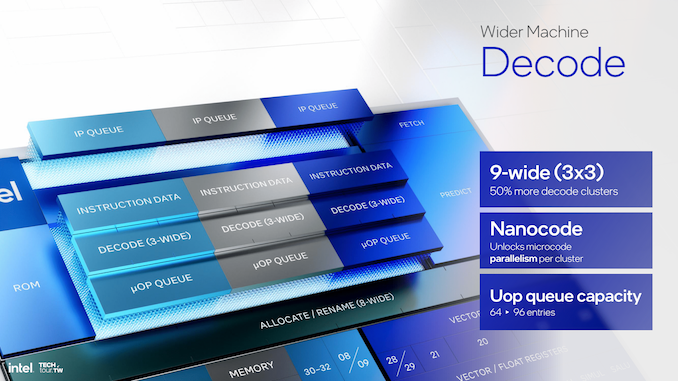
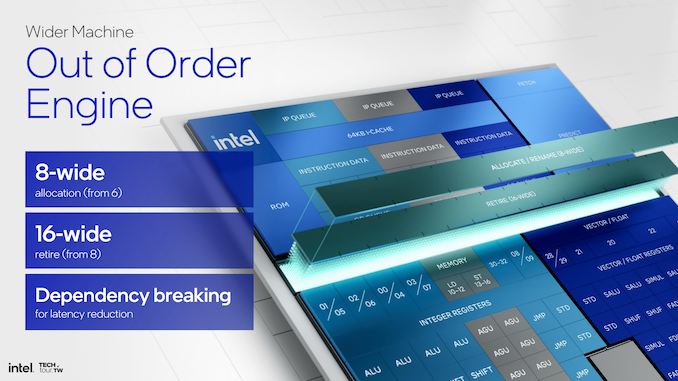
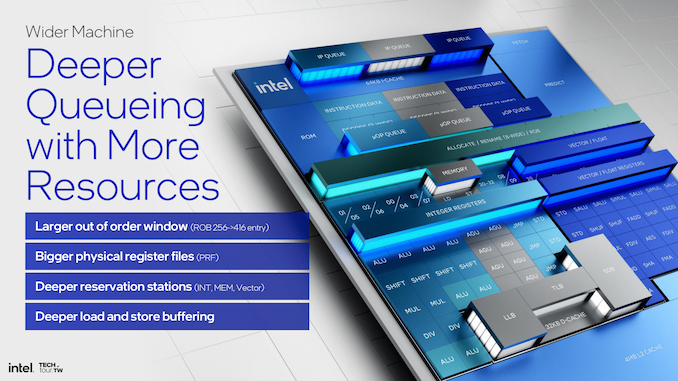


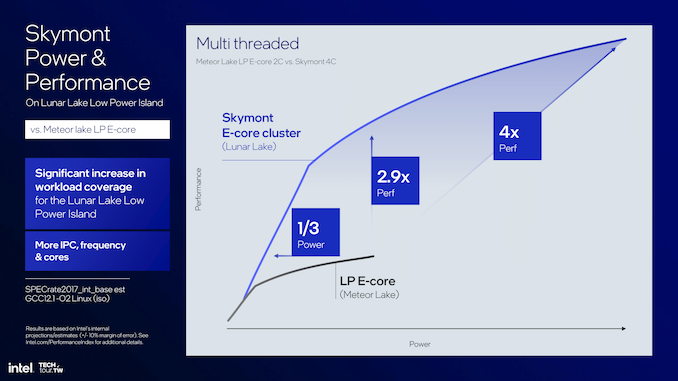
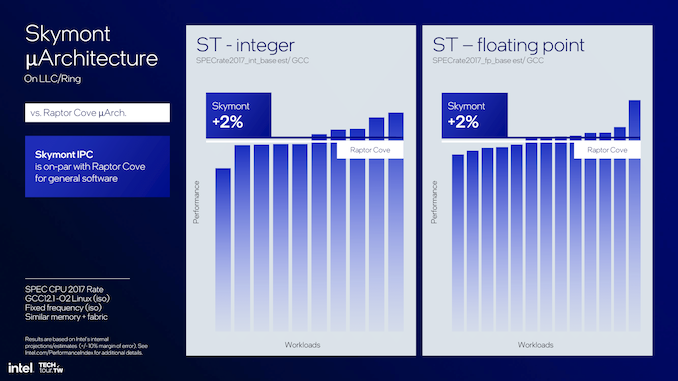
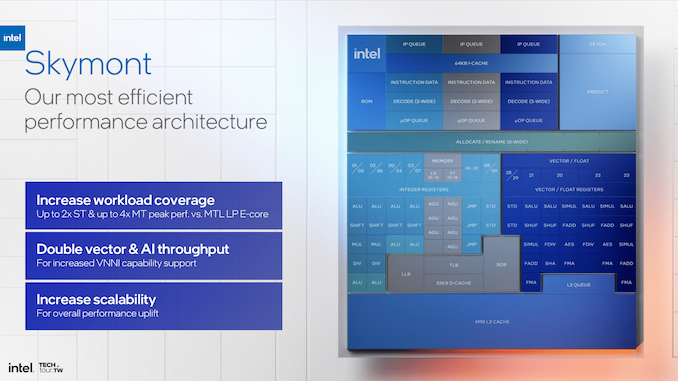








90 Comments
View All Comments
BushLin - Wednesday, June 5, 2024 - link
Seconded, also..."Gavin Bonshor - Tuesday, May 21, 2024 - link
Hey, thank you for saying that. They are coming as soon as I can get the data updated. I had to fly out to the USA last Monday evening, and the testing wasn't finished in time. I also don't typically work weekends, but I made an exception in this case. I'm catching up, but don't worry, it will be updated ASAP." Reply
TheinsanegamerN - Monday, June 10, 2024 - link
Nope. We never got that Macbook review or the return of the GPU benchmarks. Replyjaj18 - Tuesday, June 4, 2024 - link
What's the improvement from on package memory🤔? Replyrgreen1983 - Tuesday, June 4, 2024 - link
Power savings. Trading upgradeability for unplugged battery life because publications put way too much emphasis on it for years trying to make arm seem better than x86. ReplyThe Hardcard - Wednesday, June 5, 2024 - link
There’s not way to emphasis on it. Battery life is a far more mainstream issue than upgradability. Replyrgreen1983 - Wednesday, June 5, 2024 - link
I disagree. Battery life beyond a certain point is silly in a laptop, they aren't phones or tablets, which are much better suited for unplugged use for media consumption. Who the heck is spending 20 hours unplugged browsing the web? And at power performance than they would have if they were plugged in. I have supported thousands of laptops, lots of them macs, and any that do real work are plugged in.Battery life used to be measured in minutes and was a big deal but now that we are measuring near days it's getting silly. Reply
The Hardcard - Thursday, June 6, 2024 - link
People work plugged in because they have to, not because they want to. as more powerful workload, capable all day and multi day, devices become available, they will be the choices for huge numbers of people who can afford the price.Once all the players jump in, and there is more competition in price, extended battery life devices that can be worked on will dominate. Reply
TheinsanegamerN - Monday, June 10, 2024 - link
Maybe you want a battery that can still do a 8 hour workday 5 years after you bought it? Battery degradation is a thing you know.I could throw your question right back at you. Why does anyone need upgradeability on a modern laptop? CPUs last a LONG time, by the time the CPU is no longer fast enough, the whole generation will be unsupported anyway, and the device a relic of the past. Just buy enough memory to do what you need and use the machine.
See how easy that is? Reply
shabby - Tuesday, June 4, 2024 - link
Thanks tsmc for saving Intel's butt, they couldn't do it themselves with 10nm+++++++ ReplyNate_on_HW - Tuesday, June 4, 2024 - link
I found it interesting that they also talked about the INT8 OPS throughput of the GPU and CPUWould find it interesting to get those numbers on AMDs &Qualcomms chip and maybe plot each module of the SoCs as "TOPS/Watt" (for comparison)
I wonder if the new windows11 "on-device ML-models" would use the whole chip for computing or only the NPU. Reply